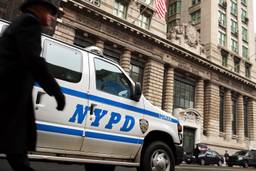The Occupy movements, in addition to being some of the most important activist movements to come along in the United States in several decades, have helped underscore several societal crises. For example, the failure of the establishment media and the rise of the beltway pundit class, the disappearance of public space, and also vanishing civil liberties, to name only a few.
Occupy has also served as a reminder of the ever-present police state, which rather than acting to “serve and protect,” oftentimes crushes and suppresses freedom of expression. We’ve witnessed this in obvious, overt, batshit crazy behavior like police using horses to stampede into a Times Square crowd, and when Oakland police turned their city into a war zone. But there are subtler, far sneakier ways so-called public servants such as firefighters and the police, and by extension city officials, use the law as a weapon, or a convenient scapegoat, to control a rebellious faction of the population.
I’m going to examine two recent examples in this post, but they are by no means meant to be a complete list. To highlight all of the ways police use the law to suppress the Occupy movements would take a book-length effort.
First, there’s the odd timing of the NYFD confiscating Occupy Wall Street’s generators and fuel because they supposedly posed a danger. OWS has been in possession of these generators and fuel for quite some time, but the fire department chose to seize them the day before the first snow of the season is due. It’s not unreasonable to suggest that Mayor Bloomberg, who previously lost a showdown with protesters over the cleaning of Liberty Park, now feels he needs to get creative with the eviction process.
Placing protesters under constant police surveillance hasn’t scared them off, nor have mass arrests, or physical abuse by police officers. If anything, these kinds of assault by the city have strengthened the movement’s public popularity. A recent Quinnipiac University survey reported that 67 percent of New York City voters said they agree with the protesters’ views. A whopping 72 percent of voters said law-abiding demonstrators can stay “as long as they want.” Throughout the occupation, Bloomberg has looked painfully out-of-touch and foolish on several occasions, and even inept as a city leader. Surely, that has provided him with enough motivation to disguise protest sabotage as public safety.
Then there’s the outrageous example of Occupy Tucson, one of the comparatively smaller Occupy movements that has suffered a disproportionately large percentage of arrests. On any given weekday, there are about 100 occupiers demonstrating in city parks, according to Tucson Sergeant Maria Hawk. That’s not exactly a wild surge in the population, or anything that should overwhelm the city. Yet, an astonishing 351 protesters have been arrested since the genesis of the movement. Hawk admits “most of the arrests were for remaining in a city park after hours.” This was also one of the excuses given in Oakland, along with the usual, “your fuel tanks are going to raze the entire city to the ground” speech.
The citation carries a $1000 fine, a potential prison sentence of six months in jail, and up to three years probation. Tucson activists rightly view this as an effort by police to bleed the movement financially instead of using bad PR-generating pepper spray and batons. While Occupy Wall Street got its moments to publicly “battle” the police and display how a force gone wild stifles dissent, Tucson is being quietly suffocated in the dead of night, and most of the public will be none the wiser.
What’s so deeply nefarious about this kind of civil rights assassination is that curfew and fire safety laws were created with genuine good intentions. It makes sense to not want individuals walking around in secluded, dark spaces at night, or not allow people to create bonfires in the middle of grounds covered in dry grass. But these well-meaning laws are now being used to crush the First Amendment.
Some readers might be asking themselves: But Allison, how can we tell the difference between when the cops are trying to protect citizens, and when they’re using public safety laws to disguise protest sabotage? Well, it’s quite easy. Here’s an example: Let’s give the OPD some credit and assume they really were concerned protesters were going to start a fire with their fuel. Why not walk in and seize the equipment? Why escalate the enforcement of a public safety regulation into full-blown warfare on the streets of Oakland, including critically injuring a war veteran? Unless, of course, what happened in Oakland was never about public safety, and all about crushing the will of the protesters. It’s not very safe for the public to, say, shoot them with rubber bullets, tear gas them, and explode flash bang grenades in their midsts.
Another example: Let’s assume the NYPD is super freaked out by OWS having generators. Why wait until the day before first snowfall to seize them? Were these generators not a public safety issue on the first day of the occupation? What was special about October 28, 2011 that suddenly turned generators into Public Enemy Number One? Unless, of course, this has nothing to do with public safety and everything to do with crushing one of the most successful branches of the Occupy movement.
The answers to these questions should seem fairly obvious to anyone who is familiar with how law enforcement agencies prefer to handle public dissent. The NYPD, OPD, and Tucson police don’t want a bloody, drawn out war on their hands. It’ll look terrible in the media, and public sentiment is already on the side of the protesters.
What police and city officials prefer is a death by a thousand subtle little cuts. Take the generators, issue tickets, pull down the tents, and make life unbearable for the protesters. Hope they give up and go home when it snows, and if that doesn’t work, try to freeze the bastards out.




